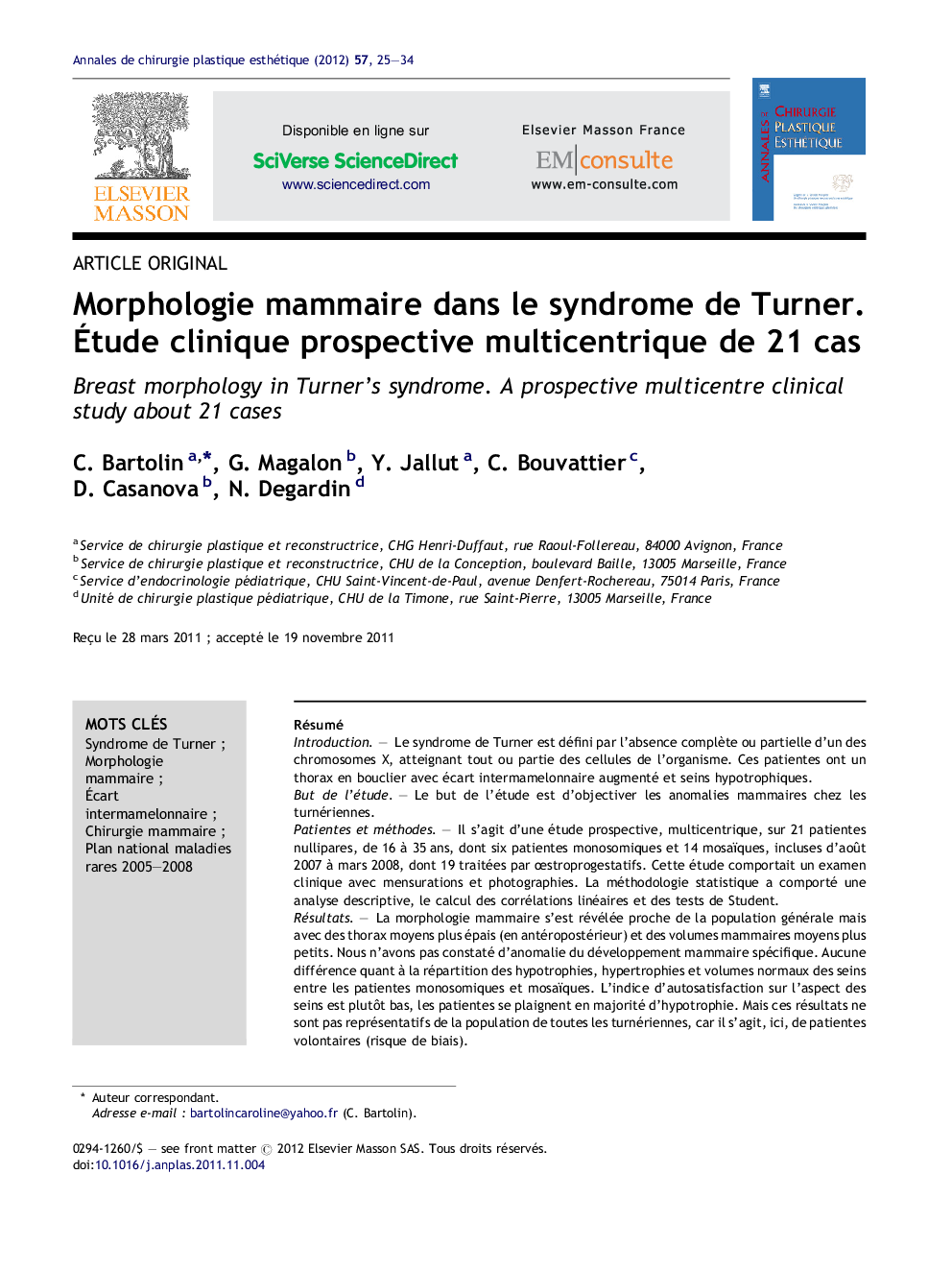| Article ID | Journal | Published Year | Pages | File Type |
|---|---|---|---|---|
| 3184805 | Annales de Chirurgie Plastique Esthétique | 2012 | 10 Pages |
RésuméIntroductionLe syndrome de Turner est défini par l’absence complète ou partielle d’un des chromosomes X, atteignant tout ou partie des cellules de l’organisme. Ces patientes ont un thorax en bouclier avec écart intermamelonnaire augmenté et seins hypotrophiques.But de l’étudeLe but de l’étude est d’objectiver les anomalies mammaires chez les turnériennes.Patientes et méthodesIl s’agit d’une étude prospective, multicentrique, sur 21 patientes nullipares, de 16 à 35 ans, dont six patientes monosomiques et 14 mosaïques, incluses d’août 2007 à mars 2008, dont 19 traitées par œstroprogestatifs. Cette étude comportait un examen clinique avec mensurations et photographies. La méthodologie statistique a comporté une analyse descriptive, le calcul des corrélations linéaires et des tests de Student.RésultatsLa morphologie mammaire s’est révélée proche de la population générale mais avec des thorax moyens plus épais (en antéropostérieur) et des volumes mammaires moyens plus petits. Nous n’avons pas constaté d’anomalie du développement mammaire spécifique. Aucune différence quant à la répartition des hypotrophies, hypertrophies et volumes normaux des seins entre les patientes monosomiques et mosaïques. L’indice d’autosatisfaction sur l’aspect des seins est plutôt bas, les patientes se plaignent en majorité d’hypotrophie. Mais ces résultats ne sont pas représentatifs de la population de toutes les turnériennes, car il s’agit, ici, de patientes volontaires (risque de biais).ConclusionsContrairement aux idées préconçues, nous n’avons pas mis en évidence d’augmentation de l’écart intermamelonnaire moyen, en valeur absolue, conformément aux données les plus récentes de la littérature qui ne constatent qu’une augmentation apparente de cet écart par rapport à la largeur thoracique.
SummaryIntroductionThe Turner's syndrome encompassed several conditions, of which monosomy X (absence of the entire sex chromosome X) is most common. It is a chromosomal abnormality in which all or part of the sex chromosomes X is absent. Typical females have two X chromosomes, but in Turner's syndrome, one of those sex chromosomes is missing or presents abnormalities. Patients show a shield shaped thorax with thick and bulging chest, breast hypotrophy and widely spaced nipples. The objective of this study was to characterize the breast abnormalities observed in Turnerian.Patients and methodsWe describe a prospective multicentric study (August 2007–March 2008) on 21 nullipar patients, ranging from 16 to 35 years old. Six were monosomic and 14 were Turner mosaic (in this case the chromosome is missing in some cells but not others), 19 were treated with estrogens and progestatives. This study was achieved through the use of clinical examinations including body, waist, hips (BWH) measurements and photography. The statistical method involved a descriptive analysis, linear correlation calculations and student test.ResultsThe breast morphology appears to be quite closed to that of the general woman population, but with average thorax volume more bulky mainly in the anteroposterior zone, and with more reduced breast volumes. No specific abnormalities in the chest development were observed. No differences in the hypotrophy, hypertrophy, and normal breast volume repartition were observed between monosomic and mosaic patients. The self-satisfaction index on the breast look is quite low, patients mainly complain about breast hypotrophy. Nevertheless, these results are not representative of the whole turnerians, since this study address only to volunteer patients and we cannot exclude possible distortions.ConclusionsIn contrast to common beliefs, we don’t have observed any increase of the average of the internipple space; this observation is in good agreement with the most recent published literature works, which report only an apparent increase of this intermamelonary distance versus the thoracic width (in front view), probably caused to an optical distortion effect.
